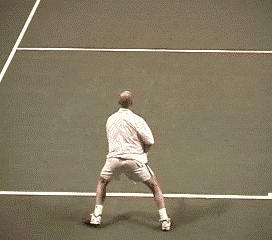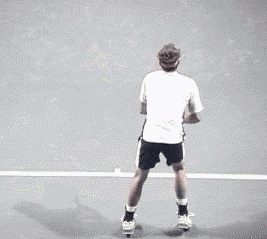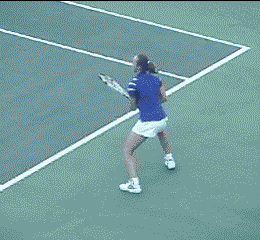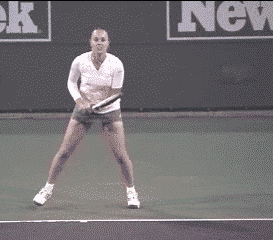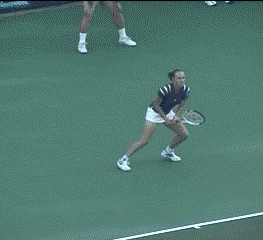|
TennisOne Lessons Cross Court Singles Patterns by Jim McLennan As I observe both adult and junior players at our club building their games, practicing, and competing in leagues and tournaments, it appears they direct most of their attention to how they hit the ball. The winners generally believe they simply hit better shots than the losers. Racquet manufacturers contribute to this scenario, for certainly every new model promises more power, more control, or more feel on the hits. And we generally admire the professionals for their big forehands, or powerful serves. But somehow, this obscures an entirely different spin on the game, and perhaps one that really separates the winners from the losers. And this point of view is one of court position. A constant awareness of your own court position, as well as that of your opponent. Face it, there is a lot of real estate to cover when playing singles, and in the final analysis shot selection and shot success boil down as much to real estate as to quality of shot. So what follows is more about playing the game rather than the nuts and bolts of hitting the ball. Shot selection, tactics, and strategy, as related to real estate. General terms
So the first contest within a singles match is the battle of the backhands, the probing for a weakness in the crosscourt rally. To see who will err first, who will blink first. Who is first to lose their nerve, or who is first to step up, step in, and control this situation. And whether it is Andy Roddick and Andre Agassi pounding backhand crosscourts, or you and I playing in a USTA league match, this is the first of many “mini battles” that ultimately decide a match. Simply consider all the decisions flowing from court position. As regards the baseline and singles sideline, I can be positioned either inside or behind the baseline, and either inside or beyond the singles sideline. And obviously, the same is true of my opponent. So if an opponent drives the ball crosscourt and deep so that you have to move behind the baseline (and note Roddick appears to strike many a two fisted backhand from well behind the baseline) the usual choices are the defensive or neutral backhand crosscourt. When positioned deep, there are less angles available on the crosscourt, and the ball will generally take longer to cross the net. The only exception would be if an opponent was way out of position, and then, and only then, would one risk a down the line or cross court winner aimed closer to the sidelines. So in this scenario, one should be content to stay in the rally and not really hope or even plan for an offensive opportunity. Approaching, ripping the ball up the line, or finessing a drop shot would all be inopportune choices.
If an opponent drives the ball sharply crosscourt, wide and short so that you move beyond the singles sideline but well in front of the baseline there will be much more real estate to traverse when recovering. In this scenario the choices include a slow cross court roller with the aim of buying time and perhaps exploring a greater angle, or a deep crosscourt floater again, looking to buy recovery time. This situation is more about finesse and feel rather than power. An up the line approach would be quite tricky, and an up the line ground stroke would place you well out of position for a crosscourt reply. If an opponent drives the ball crosscourt, but their shot is neither deep nor well angled, your offensive options ensue. If they shade to cover your crosscourt, then drive the ball up the line. If they over recovered to favor your down the line, then a crisply hit crosscourt would put them in trouble. If you choose to rally or neutralize, the opponent may realize you are less of a threat, and no longer fear you. This situation calls for offense, any other choice would be tenuous at best and incorrect. The fun occurs if this should become a four or even six shot crosscourt scenario. Which player will attempt to break the pattern by playing up the line. It would depend on length of shot, height of bounce, and positioning.
Imagine Roddick and Agassi. Andre hugs the baseline; Andy patrols from well behind the baseline. Andre knows Andy has less angle from behind the baseline, Andy knows Andre has more angle from inside the baseline. And truly in this scenario, it seems as though Agassi methodically pounds the ball on the rise while Roddick scurries back and forth. Sooner or later Andre will find a more severe angle than Andy, and now with Andy wide and out of court, Andre will select the up the line winner, and with a greater chance of success, for the risk of playing up the line across the higher net (by about 4 inches) and to the shorter length court (78 feet down the line, 82.5 feet crosscourt) is more reasonably accepted when playing inside the baseline from an offensive position. Artistry Over Brute Force Now, contrast the high powered backhand duels of Agassi and Roddick with those created by Martina Hingis. Rather than first strike, her style is thoughtful, about the counter punch, and played with infinite guile. Her variety of spin, speed and length, confounds an opponent’s rhythm and challenges their decisions. Many of her contemporaries are content, and even trained, to simply power the ball back and forth. Heavy ground strokes, often long rallies, but rarely with touch, angles, or imagination. And in these types of rallies, the issue is not so much real estate and decision and making, but rather two fighters simply slugging it out. And I believe, this in itself, creates opportunities fora player like Hingis. That is, if most of the players exchange heavy ground strokes without subtle change of pace or without varying court position, then truly these same players are not at all used to playing someone as thoughtful and varied as Hingis.
In fact, her most recent win in the third round of the Australian Open over Iveta Benesova (a big hitter who had dispatched another big hitter Mary Pierce in the previous round) showed just that. Iveta said, “She made me feel so uncomfortable because she’s very clever, a very smart player.” One point in particular stands out in the second set. Hingis is moved wide and deep into her backhand corner. She replies, perhaps inexplicably, with a down the line moon ball, which if short would open the court for a crosscourt winner from Benesova. But in this case Hingis ball was deep and in the corner, Benesova incorrectly chose to hammer the ball crosscourt but not from an attacking position, she needed time to recover but either didn’t know or didn’t care. Hingis, now easily back into position, moved forward took Benesova’s crosscourt drive early, and stroked a down the line forehand winner into the open court. It can be said again, Hingis went from defense to offense in the wink of an eye, when the opponent lost control of their own recovery time (sounds a little like Federer doesn’t it). Martina can just as easily capture the slightest bit of time when out of position with a cross court fade. Not a floater mind you, but timed to her recovery needs and nothing more. And when playing this fade perfectly, she often elicits an over hit reply, for the opponent may force the ball to the part of the court they thought was open, but notice only too late that Martina had recovered perfectly.
When inside the baseline, her offense is more about placement and playing the ball early, than it is about sheer power. And in the basic exchanges, she maneuvers her opponents into varying positions, sometimes deep, sometimes wide, sometimes inside the baseline. She draws many an over hitting error by playing the ball only a little bit short but definitely low, so her opponent must move forward and play the ball from below the net. Notice that Federer now uses a similar low and short backhand slice, challenging the baseline opponent to move forward into an area they are less accustomed to. Years ago, Arthur Ashe, after playing John McEnroe at Madison Square Garden (I think it was the season ending Masters tournament) remarked, “McEnroe’s game is like being cut with a knife. Never a knock out punch, but rather a thousand cuts, until you are bleeding to death.” Well Hingis is the WTA’s McEnroe, and she will bring out her knives on her (so far) remarkable comeback. Welcome back Kiddo, we missed you. Your comments are welcome. Let us know what you think about Jim McLennan's article by emailing us here at TennisOne.
|
||||||||||||

